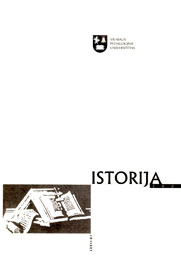Iš Vilniaus miesto socialinio žemėlapio XVII a. pirmojoje pusėje-XVIII a.: elgetų organizacijos pobūdis
The Social Map of Vilnius (1 7th-18th Centuries): Paupers' Organization
Author(s): Aivas RagauskasSubject(s): History
Published by: Vytauto Didžiojo Universitetas
Keywords: Vilnius; 17th-18th Centuries; Paupers' Organization
Summary/Abstract: The article analyses paupers' self-government and self-control in Vilnius from the first half of the 17th century till the 18th century. This research aims to verify the affirmation that Vilnius city paupers formed certain guilds. On the basis of newly interpreted scarce, mainly of normative character, sources and historiography, the conclusion can be drawn that Vilnius paupers' organization (1636-1784) was rather unique. It could be defined as an original fusion/combination of self-government and city control; it was a specific fraternity devoid of the features of a guild or church brotherhood. The data collected allow to state that this fraternity functioned on self-government principles. At the beginning of its existence, it functioned as a worldly organization; however, the first quarter of the 18th century witnesses the appearance of religious aspects: this fraternity became subject (as far as its spiritual life was concerned) to the Dean of St. John's church. Therefore, a conclusion can be drawn that to name Vilnius paupers' fraternity as a guild (this is popular in Lithuanian historic literature) is wrong. Actually, Vilnius paupers'formal social organization was one of the layers of the then Lithuanian society. Consequently, this research is interesting both for historians and general public. The author also claims that the history of Vilnius' marginal society layers needs further research, especially in the context of other West and East European cities
Journal: Istorija. Lietuvos aukštųjų mokyklų mokslo darbai
- Issue Year: 67/2007
- Issue No: 3
- Page Range: 15-23
- Page Count: 9
- Language: Lithuanian

